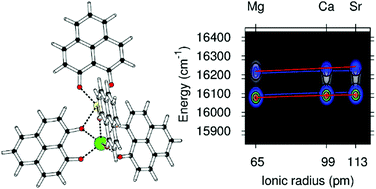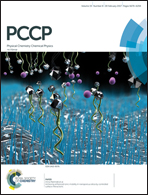Correlation of the structural information obtained for europium-chelate ensembles from gas-phase photoluminescence and ion-mobility spectroscopy with density-functional computations and ligand-field theory†
Abstract
We report a combined investigation of europium(III)9-oxo-phenalen-1-one (PLN) coordination complexes, [Eu(PLN)4AE]+ with AE = Mg, Ca, and Sr, using gas-phase photoluminescence, trapped ion-mobility spectrometry and density-functional computations. In order to sort out the structural impact of the alkali earth dications on the photoluminescence spectra, the experimental data are compared to the predicted ligand-field splittings as well as to the collision cross-sections for different isomers of [Eu(PLN)4AE]+. The best fitting interpretation is that one isomer family predominantly contributes to the recorded luminescence. The present work demonstrates the complexity of the coordination patterns of multicenter lanthanoid chelates involved in dynamical equilibria and the pertinence of using isolation techniques to elucidate their photophysical properties.



 Please wait while we load your content...
Please wait while we load your content...